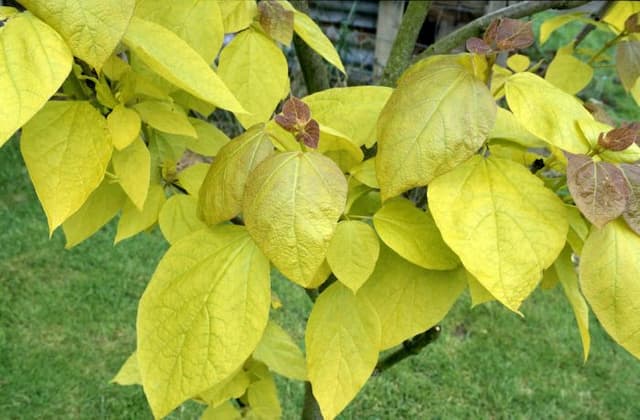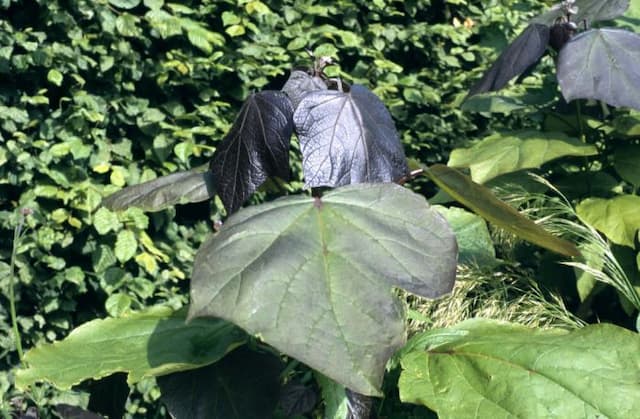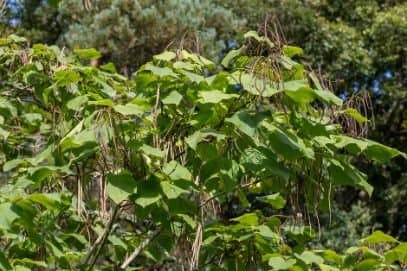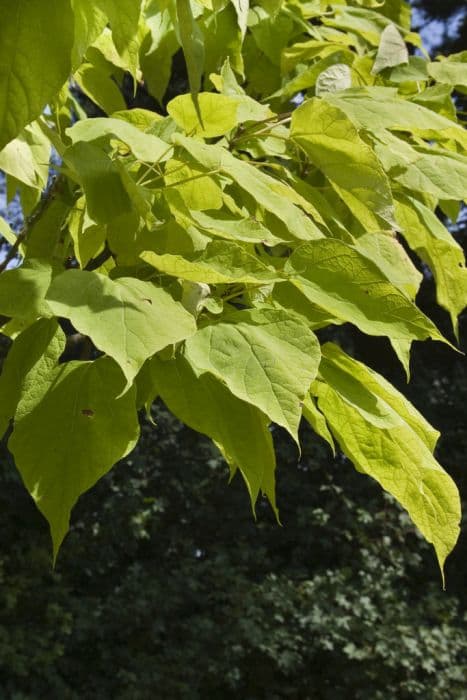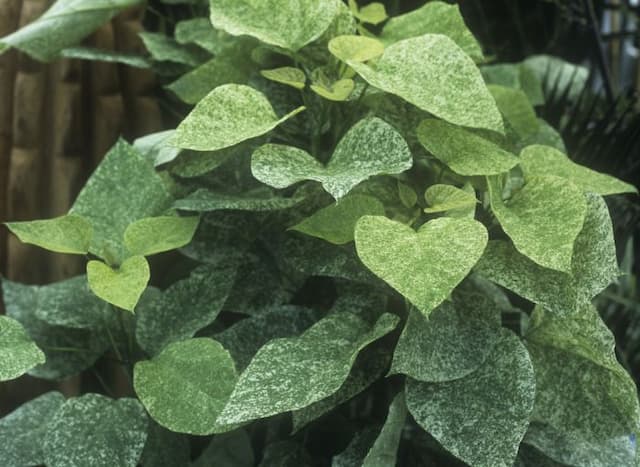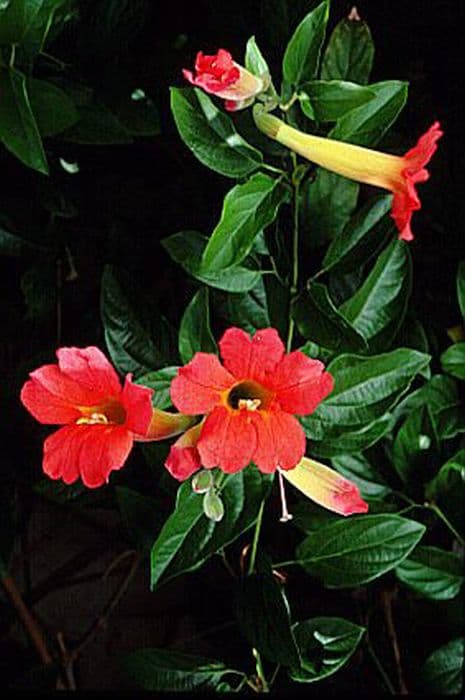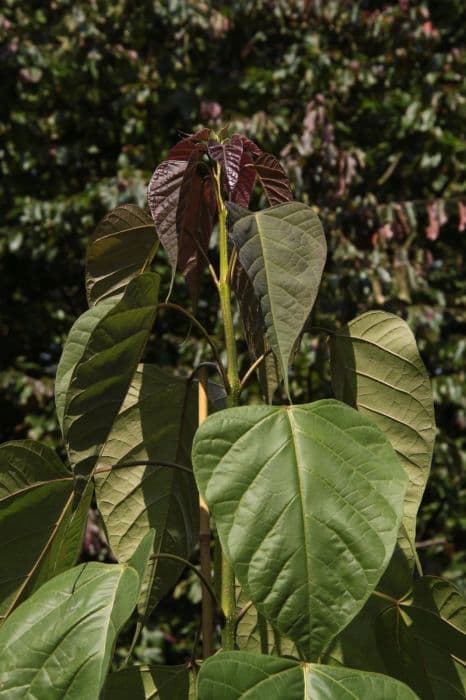Wonga Wonga Vine Pandorea pandorana

ABOUT
The plant commonly known as the Wonga Wonga Vine is a fast-growing, woody climber that can attach itself to various structures. Its foliage consists of compound leaves, each divided into several leaflets, which are bright green and glossy, giving the plant a lush, dense appearance. The leaflets are elongate, with a somewhat oval shape, and come to a gentle point at their tips. It is well-known for its spectacular floral displays. The trumpet-shaped flowers are a striking feature, typically white or cream with throats that are often marked with purple or pink. These blossoms are arranged in loose, pendulous clusters that add a delicate and somewhat tropical effect to the plant’s appearance. The flowers tend to appear in abundance from spring to early summer, attracting various pollinators with their sweet fragrance. After flowering, the Wonga Wonga Vine produces elongated seed pods which start out green and gradually turn brown as they mature. These seedpods can add further visual interest to the plant even after the blooms have faded. The vine has a vigorous habit of growth and can rapidly cover fences, arbors, and trellises, providing a quick green screen or a living shade canopy. Its adaptability and attractive appearance make it a favorite among garden plants in suitable climates. Overall, the Wonga Wonga Vine's charming flowers, lush foliage, and climbing nature make it a captivating addition to any landscape.
About this plant
 Names
NamesFamily
Bignoniaceae
Synonyms
Wonga Wonga Vine, Bower Vine, Bower Climber, Bower Plant, Bower Of Beauty
Common names
Bignonia pandorana, Tecoma australis, Tecoma pandorana, Doxantha pandorana.
 Toxicity
ToxicityTo humans
The Wonga Wonga Vine is generally not considered to be a poisonous plant to humans. There is little evidence to suggest significant toxicity, and thus it is unlikely to cause harm if ingested in small quantities. However, as with any plant not typically consumed as food, it is possible that some individuals may experience mild stomach upset or an allergic reaction if they are sensitive. If any part of the plant were to be consumed in large amounts, it is conceivable that symptoms might occur, but specific symptoms of poisoning from the Wonga Wonga Vine are not well-documented.
To pets
The Wonga Wonga Vine is not commonly listed as a toxic plant for pets. There is a lack of significant evidence to suggest that it poses a severe risk to pets if ingested. However, as with any non-food plant, consumption could potentially lead to gastrointestinal upset such as vomiting or diarrhea in sensitive animals. It is always a good practice to discourage pets from eating plants that are not specifically intended for their consumption, as individual reactions can vary and some pets might be more sensitive than others.
 Characteristics
CharacteristicsLife cycle
Perennials
Foliage type
Evergreen
Color of leaves
Green
Flower color
Pink
Height
15-20 feet (4.5-6 meters)
Spread
6-10 feet (1.8-3 meters)
Plant type
Climber
Hardiness zones
9
Native area
Australia
Benefits
 General Benefits
General Benefits- Ornamental value: The plant, commonly known as Wonga Wonga Vine, is highly decorative with attractive foliage and profuse, showy flowers.
- Habitat support: It provides food and shelter for a range of fauna, including butterflies and birds which are attracted to its nectar-rich blooms.
- Erosion control: It can be used to stabilize soil, particularly in sloped gardens, due to its vigorous climbing habit.
- Natural fencing: Wonga Wonga Vine can be utilized for creating living green fences or privacy screens in gardens.
- Shade provision: When grown over arbors or pergolas, it provides a natural shade canopy during warm months.
- Adaptability: It is tolerant of a variety of soils and conditions, making it a versatile addition to many landscapes.
- Low maintenance: Once established, it requires minimal care, making it ideal for gardeners seeking low-maintenance plants.
- Drought tolerance: Wonga Wonga Vine is relatively drought-resistant once it has been established, reducing the need for frequent watering.
 Medical Properties
Medical PropertiesThis plant is not used for medical purposes.
 Air-purifying Qualities
Air-purifying QualitiesThis plant is not specifically known for air purifying qualities.
 Other Uses
Other Uses- Wongawallan jasmine can be used to create a natural privacy screen. Its dense foliage can grow quickly, providing a green barrier in gardens and along fences.
- The vine is often used for creating shaded areas in gardens. When grown over pergolas or arbors, it provides a cool, leafy shelter during hot weather.
- Diverse wildlife habitat is supported by Wongawallan jasmine. Its dense growth offers shelter and nesting sites for birds and insects.
- It's used in horticultural therapy. The act of planting and tending to Wongawallan jasmine can be a peaceful and rehabilitative activity for individuals with disabilities or those in recovery.
- The plant can be incorporated in nature-based play spaces. Its ability to be shaped and its robustness make it suitable for creating living tunnels or secret garden nooks for children.
- Creative landscaping projects often utilize Wongawallan jasmine for topiary. With regular pruning, the plant can be trained into various forms and patterns.
- The vine's natural resilience is used to combat soil erosion. Planting Wongawallan jasmine on slopes helps stabilize the soil with its root system.
- Some cultures use the dried vines of Wongawallan jasmine for crafting purposes, such as weaving baskets or making other decorative items.
- The plant can be a suitable host for certain species of butterfly larvae, which can be a part of butterfly gardening efforts to promote biodiversity.
- As an element in sound barrier vegetation, Wongawallan jasmine's dense growth can help dampen noise when planted along highways or busy roads.
Interesting Facts
 Feng Shui
Feng ShuiThe Bower Vine is not used in Feng Shui practice.
 Zodiac Sign Compitability
Zodiac Sign CompitabilityThe Bower Vine is not used in astrology practice.
 Plant Symbolism
Plant Symbolism- Innocence: The delicate and pure appearance of the Pandorea pandorana, also known as the Wonga Wonga Vine, signifies innocence and the untouched beauty of nature.
- Endurance: This plant is known for its hardiness and ability to thrive in difficult conditions, symbolizing endurance and the ability to overcome challenges.
- Prosperity: The lush growth and prolific flowering nature of the Wonga Wonga Vine can be seen as a sign of abundance and prosperity.
- Resilience: With its ability to bounce back from environmental stress, the Wonga Wonga Vine represents resilience and adaptability.
- Growth: As a rapidly growing vine, it is often associated with personal or spiritual growth and the idea of progressing through stages of life.
 Water
WaterThe Bower Vine should be watered regularly to keep the soil consistently moist but not waterlogged, aiming for about one inch of water per week. During the growing season in spring and summer, watering might be necessary once or twice a week, depending on climate conditions and soil drainage. Reduce watering frequency in the fall and further in the winter to let the soil dry out slightly between waterings, as overwatering can lead to root rot. For potted Bower Vines, ensure the pot has drainage holes and water slowly until you see excess water flow from the bottom.
 Light
LightThe Bower Vine thrives best in full sun to partial shade. It should be placed in a spot where it receives at least 4 to 6 hours of sunlight a day. However, in extremely hot climates, some afternoon shade is beneficial to prevent leaf scorch.
 Temperature
TemperatureThe Bower Vine prefers a temperate to warm climate and can survive in temperatures ranging from a minimum of 20 degrees Fahrenheit to maximum temperatures well above 100 Fahrenheit. The ideal temperature for growing is between 60 to 85 Fahrenheit, which encourages healthy growth and flowering.
 Pruning
PruningPrune the Bower Vine to maintain its shape and encourage bushier growth. It should be pruned in late winter or early spring before new growth begins. Dead or damaged stems can be removed at any time. Pruning can be done annually or biannually depending on the desired size and shape of the plant.
 Cleaning
CleaningAs needed
 Soil
SoilThe Wonga Wonga Vine thrives in a well-draining soil mix that is rich in organic matter. A good recipe for this would be a mixture of loam, peat, and sand in equal parts, providing a balance of drainage and nutrient retention. The ideal soil pH for Pandorea pandorana is slightly acidic to neutral, ranging from 6.0 to 7.5.
 Repotting
RepottingWonga Wonga Vine should be repotted every two to three years, or when it has outgrown its current pot. Check the root system in spring and if it's crowded, move the plant to a larger pot to encourage continued growth and flowering.
 Humidity & Misting
Humidity & MistingWonga Wonga Vine prefers moderate to high humidity levels, which mimics its native environment in Australia. Aim for humidity levels of 50-70% for optimal growth.
 Suitable locations
Suitable locationsIndoor
Place Wonga Wonga Vine near bright, filtered light and maintain good humidity.
Outdoor
Plant Wonga Wonga Vine in semi-shade and sheltered from strong winds.
Hardiness zone
9-11 USDA
 Life cycle
Life cycleThe life cycle of Pandorea pandorana, commonly known as the Wonga Wonga Vine, begins with seed germination, which requires a warm, moist environment to initiate growth. The seedling stage follows, where it develops a root system and the first leaves or cotyledons appear. In the vegetative stage, the Wonga Wonga Vine rapidly grows stems and leaves, utilizing its climbing habit to gain sunlight; it may also form a tuberous root to store energy. When mature enough, the vine enters the flowering stage, producing its distinctive tubular flowers that are white to pale pink with a deep throat, attracting pollinators. After pollination, the vine develops fruit which are elongated capsules containing numerous winged seeds that, when mature, are released to the environment to begin a new cycle. Throughout its life, the plant can be perennial, with proper conditions allowing it to grow and flower for multiple years.
 Propogation
PropogationPropogation time
Spring-Early Summer
Propogation: The most popular method of propagation for the Wonga Wonga vine (Pandorea pandorana) is through semi-hardwood cuttings. This typically occurs during the warmer months, from late spring through to summer, when the plant's growth is most vigorous. To propagate by cuttings, select a healthy, semi-hardwood section of the vine that is about 4-6 inches (10-15 cm) long and has several leaf nodes. It's important to make a clean cut just below a node, as this is where the roots will emerge. Remove the leaves from the lower half of the cutting to prevent excessive moisture loss, dip the cut end into a rooting hormone to encourage root development, and plant it in a well-draining potting mix. Keep the cutting moist and in a warm, sheltered spot until roots have developed and it can be transplanted.
